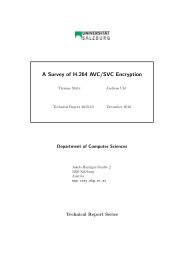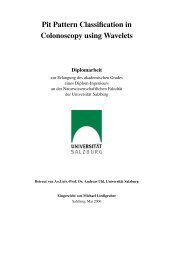Single-sensor hand and footprint-based multimodal biometric ...
Single-sensor hand and footprint-based multimodal biometric ...
Single-sensor hand and footprint-based multimodal biometric ...
Create successful ePaper yourself
Turn your PDF publications into a flip-book with our unique Google optimized e-Paper software.
3 Sensing<br />
The absolute matching performance of a <strong>biometric</strong> system largely depends on the intrinsic<br />
properties of its <strong>sensor</strong>. An example of the variations caused by different input can be<br />
seen in the quite different error rates in the FVC2006 [50] for different <strong>sensor</strong>s, causing a<br />
change of an order of magnitude in EER performance [21]. When selecting a proper <strong>sensor</strong><br />
for an online system (i.e. no latent fingerprints, palmprints, etc. are matched, but live<br />
impressions of the human <strong>h<strong>and</strong></strong> <strong>and</strong> foot), the first question which needs to be addressed<br />
is: “What should be captured?” Generally, concerning 2D impressions of the human <strong>h<strong>and</strong></strong><br />
<strong>and</strong> foot there are two possible choices: (a) volar (or palmar for <strong>h<strong>and</strong></strong>s <strong>and</strong> plantar in<br />
the case of feet, respectively) scans, i.e. images referring to either the palm of the <strong>h<strong>and</strong></strong><br />
or the sole of the foot <strong>and</strong> (b) dorsal scans, i.e. images of the upper part of the <strong>h<strong>and</strong></strong><br />
or foot. There are numerous <strong>biometric</strong> systems providing personal verification <strong>based</strong> on<br />
<strong>h<strong>and</strong></strong> images which rely on different views of the <strong>h<strong>and</strong></strong> <strong>and</strong>/or different kinds of <strong>sensor</strong>s.<br />
Another question immediately affected by the choice of an appropriate <strong>sensor</strong> is: “Can<br />
the sensing device distinguish between genuine <strong>and</strong> forged <strong>sensor</strong> input?” If systems are<br />
prone to frequent imposter attacks, it may be necessary to check whether the source of an<br />
input signal is alive or not. This is called liveness detection <strong>and</strong> may be supported by the<br />
choice of <strong>sensor</strong> [1]. It is, for example, more difficult to fool thermal <strong>sensor</strong>s than optical<br />
<strong>sensor</strong>s (sometimes even an ink print is sufficient). Also security abilities such as available<br />
encryption for decentralised data acquisition <strong>and</strong> compression influence the choice of a<br />
proper <strong>sensor</strong> [21].<br />
Furthermore, there are a set of user interface <strong>and</strong> optical system requirements [44]. Capturing<br />
devices should be intuitive in a sense that users know what to do, even without<br />
instructions. This increases throughput <strong>and</strong> decreases the number of errors due to improper<br />
<strong>sensor</strong> usage when applied in real-world applications. Real-time capabilities denote<br />
the ability of the <strong>biometric</strong> system to make the classification decision in an acceptable<br />
time. User throughput of single <strong>biometric</strong> modalities is analysed by Mansfield [23]. According<br />
to this study, mean transaction time for optical fingerprint is 9 seconds (minimum<br />
2 seconds) <strong>and</strong> for <strong>h<strong>and</strong></strong> geometry 10 seconds (minimum 4 seconds). This is on average<br />
twice as fast than vein <strong>and</strong> still 30 percent faster than face. However, when using commercially<br />
available scanners at high resolutions, it is clear that these throughput rates are<br />
unattainable. Nevertheless, a viable compromise has to be found between accuracy (in<br />
terms of resolution) <strong>and</strong> response time.<br />
Finally, <strong>sensor</strong> selection also involves the design of the <strong>sensor</strong> environment. Design goals<br />
may be to keep noise, caused by the environment or distortions, to a minimum (e.g.<br />
lighting conditions) or to maximise convenience (e.g. <strong>footprint</strong>-<strong>based</strong> capture in spas<br />
21








